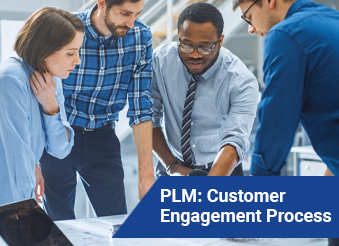
The Customer Engagement Process: The Saratech Difference
When you are ready to embark upon a Product Lifecycle Management (PLM) implementation, you may contact a few service providers to find the one that can best help you understand and achieve your goals. Undoubtedly, each will provide you with an image that overviews their process, and most likely, the main categories of each phase will look similar. It’s important to know that, although they may use the same words, all company processes are not the same. They differ in the details, and it’s those details that can make or break a project.
Five-Step Customer Engagement Process
At Saratech, we have been performing PLM implementations for more than 10 years. We have proven our process at companies in all industries and on projects of all sizes and complexities. We keep our process current by conducting thorough post-mortem meetings at the end of each engagement; our team and the clients speak openly about all aspects of the project lifecycle. When appropriate, we make refinements to our process. Below are highlights of our five-step Customer Engagement Process.
1. Discover Business Needs and Solution (Functional and Technical) Requirements
We follow a proven, robust and iterative process to ensure that we have a thorough understanding of a client’s needs before we even start thinking about developing the statement of work. Through a series of Discovery Workshops, we guide the company’s subject matter experts through the process of defining the initial business use cases (BUCs) and solution requirements. It’s important to note that we intentionally define the solution requirements as tool-agnostic to make them independent of any specific technology. Once the subject matter experts have completed the session, we work with technical team members who were not at the meeting to ensure the BUC inventory and solution requirements are complete and accurate. We then repeat the process until everyone agrees that the information is correct. We tailor the number of sessions and their length to each client.
2. Develop Commercial and Technical Proposal
With a clear understanding of the business needs, functional requirements and technical requirements, our team of experienced industry and technical professionals collaborates to create a custom statement of work (SOW). The SOW includes a schedule that takes into consideration the client’s and our availability, standard assumptions based on best practices and custom assumptions based on the company, clear metrics that detail how and when we will measure and communication project progress, and details of each involved person’s roles and responsibilities. Like in our Discovery phase, we discuss each detail with the client to ensure they are in agreement and make adjustments before finalizing the document.
3. Dedicated Project Management
We have found that when clients have a single Saratech point of contact for all communications, both the client and the Saratech team are more successful. We understand that “fit” is incredibly important, so after selecting a professional that we think is ideal for a company, we confirm that the client agrees. The single point of contact is always experienced in implementation and communications, and is responsible for keeping the project well-managed; we define a well-managed project as one that is “within the defined scope, cost and schedule.” This doesn’t mean that the scope, cost and schedule don’t evolve during the process. In fact, they almost always do. What it does mean is that changes are well thought out, thoroughly understood, and approved by the client.
4. Monitor & Control
On each engagement, Saratech provides a dedicated Project Manager and Technical Project Manager to deliver continuity and stability from start to finish. These experienced managers bring an arsenal of mature and proven project management tools to every engagement to help them monitor, control and communicate about the project. Through constant monitoring, the project managers can identify and address issues before they become challenges, and clearly communicate all aspects of the project to the appropriate Saratech and client team members. Keeping everyone informed is critical for client satisfaction.
5. Check Processes
Checking and rechecking processes is time consuming but critical. If we don’t discover an issue early in the process, it will likely have a ripple effect, creating additional issues that will take time, people and money to undo and fix. To avoid these problems, we check processes often by performing detailed risk analyses and mitigation planning using proven best practices, methodologies and key performance indicators. Through weekly activity reports that include notes on quality, contract adherence and technical compliance, we identify and address issues, or even avoid them altogether.
Trust Saratech, the Implementation Experts
The experienced PLM professionals at Saratech share a passion for customer success. You can trust them to dedicate themselves to executing your project in a manner that leverages best practices to streamline processes and keep your project aligned with your expectations about scope, cost and schedules.




